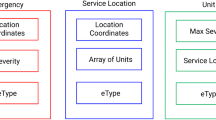Abstract
We consider an operational model of suicide bombing attacks—an increasingly prevalent form of terrorism—against specific targets, and the use of protective countermeasures based on the deployment of detectors over the area under threat. These detectors have to be carefully located in order to minimize the expected number of casualties or the economic damage suffered, resulting in a hard optimization problem for which different metaheuristics have been proposed. Rather than assuming random decisions by the attacker, the problem is approached by considering different models of the latter, whereby he takes informed decisions on which objective must be targeted and through which path it has to be reached based on knowledge on the importance or value of the objectives or on the defensive strategy of the defender (a scenario that can be regarded as an adversarial game). We consider four different algorithms, namely a greedy heuristic, a hill climber, tabu search and an evolutionary algorithm, and study their performance on a broad collection of problem instances trying to resemble different realistic settings such as a coastal area, a modern urban area, and the historic core of an old town. It is shown that the adversarial scenario is harder for all techniques, and that the evolutionary algorithm seems to adapt better to the complexity of the resulting search landscape.






Similar content being viewed by others
Notes
Note that this peak of difficulty is reflected in comparative terms with the remaining algorithms, since we are measuring performance as the deviation from the best-known solution, i.e., while absolute objective values follow a general decreasing trend for all algorithms, some of them may scale up better or worse than others resulting in difficulty peaks and upward trends when analyzing the deviation they provide.
References
Aarts EHL, Lenstra JK (1997) Local search in combinatorial optimization. Wiley, Hoboken
Abrahms M (2008) What terrorists really want: terrorist motives and counterterrorism strategy. Int Secur 32(4):78–105
Bäck T (1996) Evolutionary algorithms in theory and practice: evolution strategies, evolutionary programming, genetic algorithms. Oxford University Press, New York
Blomberg SB, Hess GD, Weerapana A (2004) An economic model of terrorism. Confl Manag Peace Sci 21(1):17–28
Central Intelligence Agency (2003) National strategy for combating terrorism. https://www.cia.gov/news-information/cia-the-war-on-terrorism/Counter_Terrorism_Strategy.pdf. Accessed 31 Jan 2018
Chicago Project on Security and Terrorism (CPOST) (2016) Suicide attack database (April 19, 2016 release) [Data File]. Retrieved from http://cpostdata.uchicago.edu/
Cotta C, Gallardo JE (2018) Metaheuristic approaches to the placement of suicide bomber detectors. J Heuristics 24(3):483–513
De Jong KA, Potter MA, Spears WM (1997) Using problem generators to explore the effects of epistasis. In: Bäck T (ed) Proceedings of the 7th international conference on genetic algorithms. Morgan Kaufmann, Burlington, pp 338–345
Edwards D, McMenemy L, Stapley S, Patel H, Clasper J (2016) 40 years of terrorist bombings—a meta-analysis of the casualty and injury profile. Injury 47(3):646–652
Ganor B (2011) Trends in modern international terrorism. In: Weisburd D, Feucht T, Hakimi I, Mock L, Perry S (eds) To protect and to serve. Policing in an age of terrorism. Springer, New York, pp 11–42
Gares KL, Hufziger KT, Bykov SV, Asher SA (2016) Review of explosive detection methodologies and the emergence of standoff deep UV resonance Raman. J Raman Spectrosc 47(1):124–141
Glover F (1989) Tabu search-part I. ORSA J Comput 1:190–206
Glover F (1990) Tabu search-part II. ORSA J Comput 2:4–32
Hoffman B (2003) The logic of suicide terrorism. The Atlantic. http://www.theatlantic.com/magazine/archive/2003/06/the-logic-of-suicide-terrorism/302739/. Accessed 2 July 2016
Hoos H, Stützle T (2005) Stochastic local search. Foundations and applications. Morgan Kaufmann, Burlington
Kaplan EH, Kress M (2005) Operational effectiveness of suicide–bomber–detector schemes: a best-case analysis. Proc Natl Acad Sci USA 102(29):10399–10404
Kim M, Batta R, He Q (2016) Optimal routing of infiltration operations. J Transp Secur 9(1):87–104
Lara-Cabrera R, González-Pardo A, Benouaret K, Faci N, Benslimane D, Camacho D (2017) Measuring the radicalisation risk in social networks. IEEE Access 5:10892–10900
Leistedt SJ (2016) On the radicalization process. J Forensic Sci 61(6):1588–1591
Michalewicz Z (1992) Genetic algorithms + data structures = evolution programs. Springer, Berlin
Neri F, Cotta C, Moscato P (eds) (2012) Handbook of memetic algorithms, studies in computational intelligence, vol 379. Springer, Berlin
Nie X, Batta R, Drury CG, Lin L (2007) Optimal placement of suicide bomber detectors. Mil Oper Res 12(2):65–78
Patterson MR, Patterson SJ (2010) Unmanned systems: an emerging threat to waterside security: bad robots are coming. In: 2010 international waterside security conference. IEEE Press, pp 1–7
Rand Corporation (2009) RAND database of worldwide terrorism incidents [Data File]. http://smapp.rand.org/rwtid/search_form.php
Tutun S, Khasawneh MT, Zhuang J (2017) New framework that uses patterns and relations to understand terrorist behaviors. Expert Syst Appl 78:358–375
Yan X, Nie X (2016) Optimal placement of multiple types of detectors under a small vessel attack threat to port security. Transp Res Part E Logist Transp Rev 93:71–94
Acknowledgements
This work is supported by the Spanish Ministerio de Economía and European FEDER under Projects EphemeCH (TIN2014-56494-C4-1-P) and DeepBIO (TIN2017-85727-C4-1-P).
Author information
Authors and Affiliations
Corresponding author
Rights and permissions
About this article
Cite this article
Cotta, C., Gallardo, J.E. New perspectives on the optimal placement of detectors for suicide bombers using metaheuristics. Nat Comput 18, 249–263 (2019). https://doi.org/10.1007/s11047-018-9710-1
Published:
Issue Date:
DOI: https://doi.org/10.1007/s11047-018-9710-1




